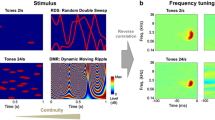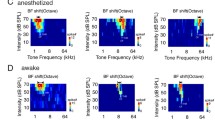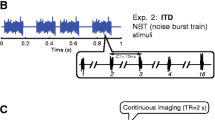Summary
Monaural and binaural single unit responses to frequency-modulated (FM) sweeps were compared in cat primary auditory cortex (AI). Both upward-directed (changing from low to high frequency) and downward-directed (changing from high to low frequency) FM sweeps were presented monaurally and binaurally at five rates of frequency modulation (referred to here as the speed of FM sweep). Two types of binaural FM sweep conditions were presented: (1) like-directed FM sweeps, in which identical FM sweeps were presented to both ears, and (2) opposite-directed FM sweeps, in which one ear was presented with one direction of FM sweep while the other ear was simultaneously presented with the opposite direction of FM sweep. In a sample of 78 cells, 33 cells were classified as EE (binaural facilitatory) and 45 were classified as EI (binaural inhibitory). Ninety-four percent of all units were sensitive to the direction and/or speed of FM sweeps. In general, under binaural stimulus conditions, EE cells responded optimally to like-directed FM sweeps, while EI cells preferred opposite-directed FM sweeps. When tested monaurally, 59% of all cells (both EE and EI) were direction selective, with the majority (76%) preferring downward-directed FM sweeps. When tested binaurally, most direction selective EE cells (60%) preferred upward-directed FM sweeps, while the majority of direction selective EI cells (71%) preferred downward-directed FM sweeps. Our analysis also allowed us to classify inhibitory responses of EI cells as either direction selective (37%) or non-direction selective (63%). For FM speed selectivity under monaural conditions, most EE cells preferred fast FM sweep rates (0.4–0.8 kHz/ms), while approximately equal numbers of EI cells preferred either slow (i.e., 0.05–0.1 kHz/ms) or fast (i.e., 0.4–0.8 kHz/ms) speeds. Under binaural conditions, the majority of EE and EI cells responded best to high speeds when tested with like-directed FM sweeps, while the preferred speed with opposite-directed FM sweeps was more broadly tuned. The results suggest the presence of binaural neural mechanisms underlying cortical FM sweep direction and speed selectivity.
Similar content being viewed by others
References
Arthur RM, Pfeiffer RR, Suga N (1971) Properties of “two tone inhibition” in primary auditory neurones. J Physiol (Lond) 212:593–609
Britt R, Starr A (1976) Synaptic events and discharge patterns of cochlear nucleus. II. Frequency modulated tones. J Neurophysiol 31:179–193
Clopton BM, Winfield JA (1974) Unit responses in the inferior colliculus of rat to temporal auditory patterns of tone sweeps and noise bursts. Exp Neurol 42:532–540
Cynader M, Chernenko G (1976) Abolition of direction selectivity in the visual cortex of the cat. Science 193:504–505
Cynader M, Regan D (1978) Neurones in cat parastriate cortex sensitive to the direction of motion in three-dimensional space. J Physiol (Lond) 274:549–569
Cynader M, Regan D (1982) Neurons in cat visual cortex tuned to the direction of motion in depth: effect of positional disparity. Vision Res 22:967–982
Erulkar SD, Butler RA, Gerstein GL (1968) Excitation and inhibition in cochlear nucleus. II. Frequency-modulated tones. J Neurophysiol 31:637–648
Gardner RB, Wilson JP (1979) Evidence for direction-specific channels in the processing of frequency modulation. J Acoust Soc Am 66:704–709
Grasse KL, Ariel M, Smith ID (1990) Direction-selective responses of units in the dorsal terminal nucleus of cat following intravitreal injections of bicuculline. Vis Neurosci 6:604–617
Kay RH (1982) Hearing of modulation in sounds. Physiol Rev 62:894–975
Kay RH, Matthews DR (1972) On the existence in human auditory pathways of channels selectively tuned to the modulation present in frequency-modulated tones. J Physiol (Lond) 225:657–677
Mendelson JR (1992) Neural selectivity for interaural frequency disparity in cat primary auditory cortex. Hear Res 58:47–56
Mendelson JR, Cynader MS (1985) Sensitivity of cat primary auditory cortex (AI) neurons to the direction and rate of frequency modulation. Brain Res 327:331–335
Mendelson JR, Schreiner CE, Sutter ML, Grasse KL (1992) Functional topography of cat primary auditory cortex: responses to frequency modulated sweeps. Exp Brain Res (in press)
Merzenich MM, Knight PL, Roth GL (1975) Representation of cochlea within primary auditory cortex in the cat. J Neurophysiol 38:231–249
Moller AR (1974) Coding of sounds with rapidly varying spectrum in the cochlear nucleus. J Acoust Soc Am 55:631–640
Moody DB, May B, Cole DM, Stebbins WC (1986) The role of frequency modulation in the perception of complex stimuli by primates. Exptal Biol 45:219–232
Nabelek IV, Nabelek AK, Hirsh IJ (1970) Pitch of tone bursts of changing frequency. J Acoust Soc Am 48:536–553
Nabelek IV, Nabelek AK, Hirsh IJ (1972) Pitch of sound bursts with continuous or discontinuous change of frequency. J Acoust Soc Am 53:1305–1312
Nelson PG, Erulkar SD, Bryan JS (1966) Responses of units of the inferior colliculus to time-varying acoustic stimuli. J Neurophysiol 29:834–860
Nomoto M (1980) Discharge patterns of the primary auditory cortex in cats. Jpn J Physiol 30:427–442
Phillips DP, Mendelson JR, Cynader MS, Douglas RM (1985) Responses of single neurones in cat auditory cortex to time-varying stimuli: frequency-modulated tones of narrow excursion. Exp Brain Res 58:443–454
Phillips DP, Hall SE (1987) Responses of single neurons in cat auditory cortex to time-varying stimuli: linear amplitude modulations. Exp Brain Res 67:479–492
Pick GF (1979) A study of frequency transition in cat vocalization. J Acoust Soc Am 66:594–597
Poon PWF, Chen X, Hwang JC (1991) Basic determinants for FM responses in the inferior colliculus of rats. Exp Brain Res 83:598–606
Rees A, Moller AR (1983) Responses of neurons in the inferior colliculus of the rat to AM and FM tones. Hearing Res 10:301–330
Regan D, Tansley BW (1979) Selective adaptation to frequency-modulated tones: Evidence for an information-processing channel selectively sensitive to frequency changes. J Acoust Soc Am 65:1249–1257
Sachs MB, Kiang NYS (1968) Two-tone inhibition in auditory nerve fibers. J Acoust Soc Am 43:1120–1128
Sellick PM, Russell IJ (1979) Two tone suppression in cochlear hair cells. Hear Res 1:227–236
Shore SE, Nuttall AL (1985) High-synchrony cochlear compound action potentials evoked by rising frequency-swept tone bursts. J Acoust Soc Am 78:1286–1295
Shore SE, Clopton BM, Au YN (1987) Unit responses in ventral cochlear nucleus reflect cochlear coding of rapid frequency-sweeps. J Acoust Soc Am 82:471–478
Sinex DG, Geisler CD (1981) Auditory-nerve fiber responses to frequency-modulated tones. Hearing Res 4:127–148
Suga N (1965a) Functional properties of auditory neurones in the cortex of echo-locating bats. J Physiol (Lond) 181:671–700
Suga N (1965b) Analysis of frequency modulated sounds by auditory neurons of echo-locating bats. J Physiol (Lond) 179:26–53
Suga N (1968) Analysis of frequency-modulated and complex sounds by single auditory neurones of bats. J Physiol (Lond) 198:51–80
Suga N (1969) Classification of inferior collicular neurones of bats in terms of responses to pure tones, FM sounds, and noise bursts. J Physiol 200:555–574
Tansley BW, Regan D (1979) Separate auditory channels for unidirectional frequency modulation and unidirectional amplitude modulation. Sensory Proc 3:132–140
Vartanian IA (1974) On mechanisms of specialized reactions of central auditory neurons to frequency-modulated sounds. Acustica 31:305–310
Watanabe T (1972) Fundamental study of the neural mechanisms in cats subserving the feature extraction process of complex sounds. Jpn J Physiol 22:569–583
Whitfield IC, Evans EF (1965) Responses of auditory cortical neurons to stimuli changing frequency. J Neurophysiol 28:655–672
Whitfield IC, Purser D (1972) Microelectrode study of the medial geniculate body in unanesthetized free-moving cats. Brain Behav Evol 6:311–322
Author information
Authors and Affiliations
Rights and permissions
About this article
Cite this article
Mendelson, J.R., Grasse, K.L. A comparison of monaural and binaural responses to frequency modulated (FM) sweeps in cat primary auditory cortex. Exp Brain Res 91, 435–454 (1992). https://doi.org/10.1007/BF00227840
Received:
Accepted:
Issue Date:
DOI: https://doi.org/10.1007/BF00227840




